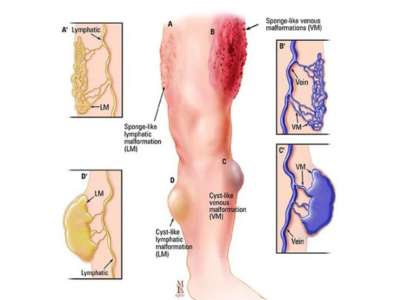What are Vascular Malformations?
Vascular malformations are a group of abnormal blood vessel formations that occur during fetal development. They are characterized by structural abnormalities in the blood vessels, leading to various symptoms and complications.
Definition and Classification:
Vascular malformations are non-cancerous growths that arise from errors in the development of blood vessels. They are classified into different types based on the specific characteristics of the abnormal vessels.
Types of Vascular Malformations:
Common types of vascular malformations include arteriovenous malformations (AVMs), venous malformations (VMs), lymphatic malformations (LMs), and capillary malformations (CMs). Each type has distinct features and requires individualized treatment approaches.
Causes and Risk Factors
The exact causes of vascular malformations are not fully understood. However, certain factors are believed to contribute to their development.
Developmental Abnormalities:
Vascular malformations occur during fetal development when blood vessels do not form or connect properly. These abnormalities can lead to the development of abnormal blood vessel networks.
Genetic Factors:
In some cases, genetic mutations or inherited conditions can increase the risk of developing vascular malformations. Research is ongoing to identify specific genes associated with these conditions.
Environmental Factors:
Although rare, certain environmental factors, such as exposure to certain chemicals or medications during pregnancy, have been implicated in the development of vascular malformations. However, more research is needed to establish clear causative links.
Symptoms and Signs
The symptoms and signs of vascular malformations can vary depending on the type, size, and location of the malformation.
Common Symptoms:
Common symptoms include localized pain, swelling, warmth, and discoloration of the affected area. Some individuals may also experience functional impairments, such as difficulty with movement or impaired organ function.
Location-Specific Manifestations:
The symptoms may differ based on the location of the malformation. For example, facial malformations can lead to disfigurement and affect speech and vision, while malformations in the limbs can cause swelling, pain, and limitations in mobility.
Diagnosing Vascular Malformations
Diagnosing vascular malformations involves a combination of physical examination, imaging techniques, and, in some cases, biopsy or genetic testing.
Physical Examination:
During a physical examination, your healthcare provider will assess the appearance, texture, and temperature of the affected area. They may also evaluate the functionality of nearby structures.
Imaging Techniques:
Various imaging techniques, such as ultrasound, magnetic resonance imaging (MRI), computed tomography (CT), and angiography, are used to visualize the malformation, determine its extent, and evaluate its impact on surrounding tissues.
Biopsy and Genetic Testing:
In certain cases, a biopsy may be performed to obtain a tissue sample for examination. Additionally, genetic testing may be recommended to identify any associated genetic conditions or mutations.
Complications and Associated Conditions
Vascular malformations can lead to a range of complications and may be associated with certain syndromes or conditions.
Functional Impairment:
Depending on the location and size of the malformation, functional impairments may occur. These can include difficulties with movement, pain, impaired organ function, or compression of nearby structures.
Cosmetic Concerns:
Vascular malformations in visible areas, such as the face or limbs, can cause cosmetic concerns and affect a person's self-esteem and quality of life.
Syndromes and Syndromic Associations:
Some vascular malformations are associated with specific genetic syndromes or conditions, such as Sturge-Weber syndrome or Klippel-Trenaunay syndrome. These syndromes may have additional symptoms and complications beyond the vascular malformation itself.
Treatment Options for Vascular Malformations
The treatment of vascular malformations depends on various factors, including the type, size, location, and symptoms associated with the malformation.
Observation and Monitoring:
In some cases, small or asymptomatic vascular malformations may not require immediate treatment. Regular monitoring and observation may be recommended to ensure there are no significant changes or complications over time.
Medications:
Certain medications, such as beta-blockers or sirolimus, may be used to manage symptoms or slow down the growth of the malformation. Medications can be beneficial in specific cases, but their effectiveness may vary depending on the type of malformation.
Minimally Invasive Procedures:
Various minimally invasive procedures, including sclerotherapy, embolization, or laser therapy, may be employed to treat vascular malformations. These techniques aim to shrink or close off the abnormal blood vessels, reducing symptoms and preventing complications.
Surgical Interventions:
Surgical removal or resection of the malformation may be necessary in certain cases, particularly for larger or more complex malformations. Surgery aims to completely remove the malformation and restore normal blood flow and function.
Emotional and Psychological Support
Coping with vascular malformation can be emotionally challenging for individuals and their families. Seeking emotional and psychological support can play a crucial role in managing the impact of the condition.
Coping with Vascular Malformations:
Learning about the condition, connecting with support groups, and seeking counseling can help individuals and their families cope with the emotional and psychological aspects of living with a vascular malformation.
Support Groups and Counseling:
Joining support groups or seeking counseling services can provide a safe space to share experiences, obtain information, and receive emotional support from others facing similar challenges.
Seeking Expert Vascular Care
At
VascularHyd, we specialize in providing exceptional care for vascular malformations. Our team of experienced vascular surgeons, state-of-the-art facilities, and personalized treatment approaches ensure the highest level of care and positive outcomes.
Why Choose VascularHyd?
- Expertise in vascular malformations and their treatment
- Comprehensive diagnostic capabilities
- Advanced treatment options
- Patient-centered approach
- Collaborative care with a multidisciplinary team
- Commitment to patient education and support
Frequently Asked Questions (FAQs):
Conclusion:
Vascular malformations are complex conditions that require comprehensive understanding and individualized care. By learning about the causes, symptoms, diagnostic approaches, treatment options, and available support, individuals affected by vascular malformations can make informed decisions about their health. At VascularHyd, we are dedicated to providing expert care and support throughout your journey.
Contact us today to schedule a consultation and take the first step toward effective management and improved quality of life.
